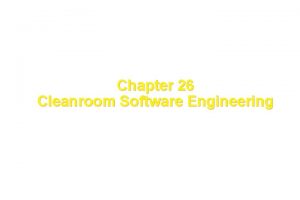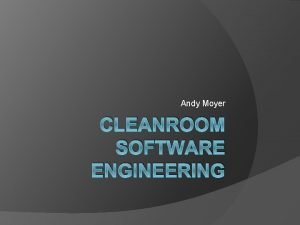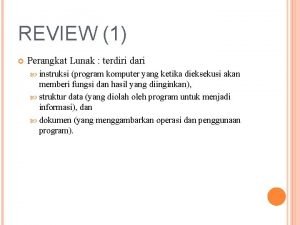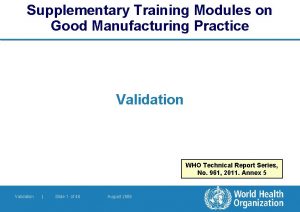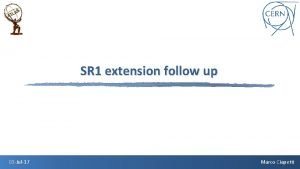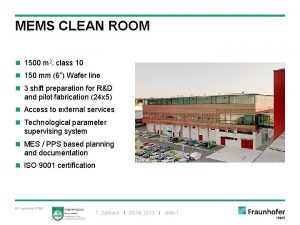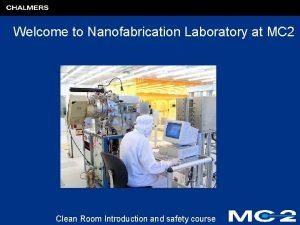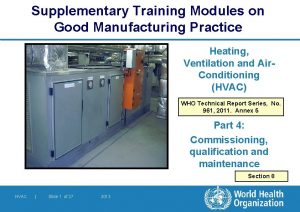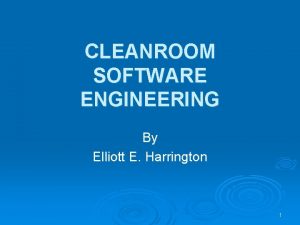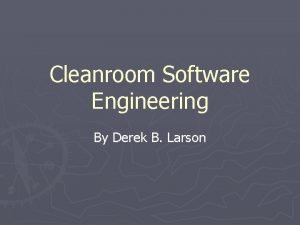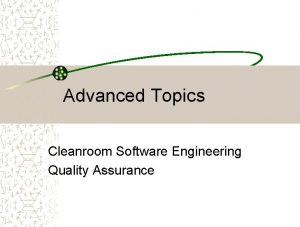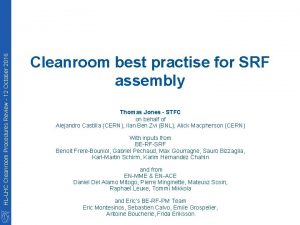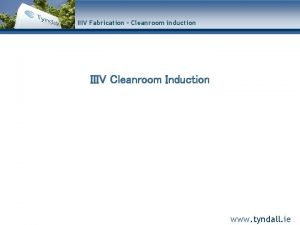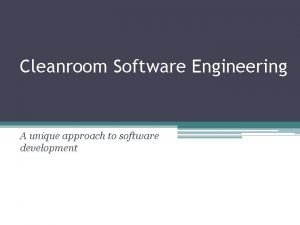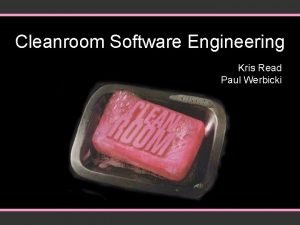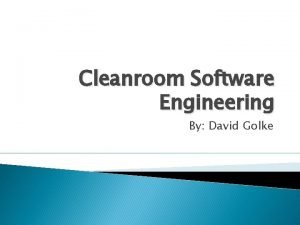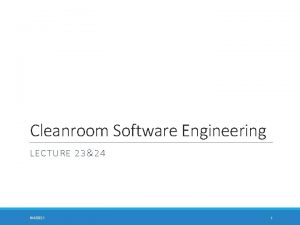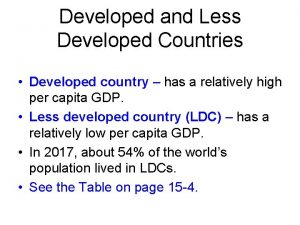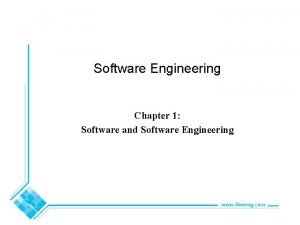Chapter 26 Cleanroom Software Engineering 1 Cleanroom Developed



















- Slides: 19

Chapter 26 Cleanroom Software Engineering 1

Cleanroom • Developed in early 80’s by Harlan Mills • Reported very good results – reliable, high-quality software – inexpensively and quickly produced • Not used very much • Moderate use of formal methods 329 -27 2

Moderate? • Extreme use of formal methods – prove theorems in a formal language – a program checks all proofs • Moderate use of formal methods – prove theorems on a whiteboard – a group of people talk about the proof until all are satisfied 329 -27 3

Cleanroom increment • • Requirements gathering Box structure specification Formal design Correctness verification (proofs) Code generation Code inspection Statistical use testing Certification 329 -27 4

Testing • Purpose is to estimate quality • Purpose is NOT to improve quality – if there a significant number of bugs, do it over • Tests are generated based on – what users actually do – probability that event will occur 329 -27 5

Statistical use testing • Make model of how the system will be used • List the set of stimuli that cause the software to change its behavior • Estimate the probability of each stimuli • Generate tests based on probability 329 -27 6

The formal part • Box structure specification • Formal design • Correctness verification (proofs) • Goal: produce code that matches specification 329 -27 7

Box Specification • BB - black box – sequence of stimuli (input events) – response – rules that map stimuli to response 329 -27 8

Black box bank account • Stimuli – deposit x, withdraw y, check-balance • Results – OK, BOUNCE, BALANCE z • Bank. Account is a function Bank. Account( stimulus. History: Seq of Stimuli, stimulus: Stimuli) -> Results 329 -27 9

Black box bank account Define function balance(Seq of Stimuli) • balance({}) = 0 • balance(SS+S) = – if (S = withdraw X) and X <= balance(SS) then balance(SS) - X – if (S = deposit X) then balance(SS)+X – ottherwise, balance(SS) 329 -27 10

Black box bank account Bank. Account(stim. H, s) if s = balance then BALANCE stim(H) else if s = deposit X then OK else “s = withdrawal X” if X <= balance(stim. H) then OK else BOUNCE 329 -27 11

Box specification • SB - state box – single stimulus (input event) – response – state – rules that map stimulus and old state to response and new state 329 -27 12

State box bank account Bank account has one variable: balance Bank. Account(s) if s = balance then BALANCE balance else if s = deposit X then balance’ = balance + X and OK else if x = withdraw X then if X <= balance then balance’ = balance - X and OK else BOUNCE 329 -27 13

Boxes • BB: S, T => R where S is a sequence of stimuli, T is a stimulus, and R is a result • SB: S, P => R, Q where S is a stimulus, P and Q are states, and R is a result. • CB: Clear box can use any code to specify the function from stimuli to responses. 329 -27 14

Design • Design is the step of converting a Black Box or State Box into a Clear Box. • Clear Box is usually described by pseudocode. • For each step of the design, the designers prove that the step is correct. • Each kind of step has a rule for proving it correct. 329 -27 15

Code generation • Once a design is expressed only as Clear Boxes, it is easy to translate into a programming language like C or Java. • The programmers translate the design into code. 329 -27 16

Advantages of Cleanroom • • • Verification becomes a finite process Improves quality Can verify every line of design and code It results in a near zero defect level It scales up It produces better code than unit testing 329 -27 17

Near Zero Defect Level? KLOC, error/KLOC Ericsson OS-32: 3501 1. 7 improvement HP 3. 5 1. 4 IBM 107 2. 6 486 LOC/PM IBM 86 1. 2 US Army 75 0. 8 4. 8 improvement 329 -27 18

Summary • If reliability is very important, Cleanroom techniques should be considered • Reasonably efficient of programmer time • Works for groups of 70 programmers • Not popular, and there are probably reasons 329 -27 19
 Cleanroom
Cleanroom Keegan moyer model
Keegan moyer model Bay chase cleanroom
Bay chase cleanroom Liquid xenon
Liquid xenon Pendekatan cleanroom adalah
Pendekatan cleanroom adalah Pal mal cleanroom
Pal mal cleanroom Cleanroom 380v sockets
Cleanroom 380v sockets Cleanroom orbital welding
Cleanroom orbital welding Mems clean room
Mems clean room Chalmers cleanroom
Chalmers cleanroom Pal mal cleanroom
Pal mal cleanroom Cleanroom bournemouth
Cleanroom bournemouth Computer based system engineering in software engineering
Computer based system engineering in software engineering Forward engineering in software engineering
Forward engineering in software engineering Software maintenance in software engineering ppt
Software maintenance in software engineering ppt What is software implementation in software engineering
What is software implementation in software engineering Metrics computer science
Metrics computer science Software crisis in software engineering
Software crisis in software engineering Software measurement and metrics
Software measurement and metrics Real time software design in software engineering
Real time software design in software engineering
